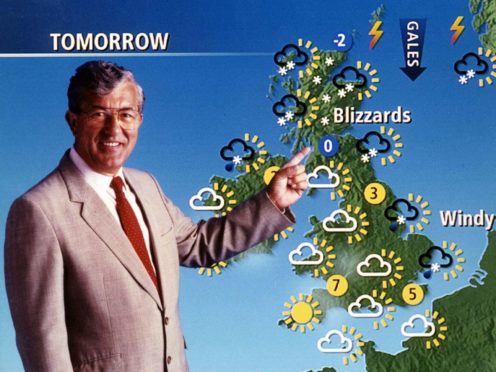Former senior BBC weatherman Bill Giles has described the corporation’s new-look weather forecasts as “disappointing as a downpour in high summer”.
The broadcaster ditched the state-owned Met Office in favour of MeteoGroup last year and has revamped its forecasts.
New graphics – which were previously provided by MetraWeather – include new map projections and a globe graphic that allows presenters to move around the world to display weather-related data.
But Giles, who led the BBC weather team for 17 years until he retired from the Met Office in 2000, said the new “state-of-the-art graphics” are “a severe disappointment” which fail to give “a clear idea of what might be in store tomorrow”.
Writing in the Radio Times, he said the UK map “appears a lot smaller on the screen now” and that he struggles to distinguish between “cloud and sunshine”, which he said is “almost impossible to detect”.
“For the life of me, I don’t understand why they have to show the lights on during the night time,” he said.
“This is supposed to be a weather map not an aerial photograph.”
Giles said he also finds it difficult to determine the predicted temperature during a forecast.
He said “the old weather maps were better, more fit for purpose” and added that viewers would be better off watching rival TV channels to “see what the weather has in store”.
A BBC spokeswoman said: “BBC Weather has a more realistic map which presenters can customise by adding different layers of data to tell the most relevant weather story, as well as zooming in to areas of interest to give a more detailed forecast.
“Towns and city names on the maps are a reference point for audiences and we will aim to ensure that most locations are represented over a period of time. In addition, the temperature colours are now accessible for colour blindness, unlike the suggested blocks of colour by Mr Giles.
“Before the launch of the new services we talked to audiences at length to pinpoint the best possible improvements and we are confident that overall people will appreciate the new features.”
Temperatures will be on the rise over the next few days… Jo pic.twitter.com/ytuz336H5y
— BBC Weather (@bbcweather) March 19, 2018
Liz Howell, the BBC’s Head of Weather, said in February: “We know how important weather is to all of our audiences both in the UK and globally, so I am delighted to be able to bring them a refreshed look, new data and additional functionality.”
In August 2015, the Met Office confirmed it had lost the contract to provide weather services, marking the end of a more than 90-year partnership between the forecaster and the broadcaster.
MeteoGroup took over in 2017 and provides forecasting and graphics for weather services across BBC platforms worldwide, including TV, radio, web and mobile.
The corporation’s new provider is the UK’s largest private-sector weather business, with offices in more than 15 countries around the world.
The Radio Times is on sale now.
